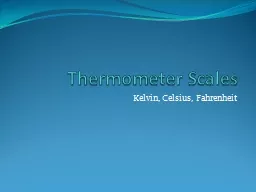

Kelvin Celsius Fahrenheit Fahrenheit In the 1700s G Daniel Fahrenheit developed a scale used by meteorologists for measuring surface temperature The scale was named for the developer and the unit of measure has become known as degree Fahrenheit F ID: 563295
Download Presentation The PPT/PDF document "Thermometer Scales" is the property of its rightful owner. Permission is granted to download and print the materials on this web site for personal, non-commercial use only, and to display it on your personal computer provided you do not modify the materials and that you retain all copyright notices contained in the materials. By downloading content from our website, you accept the terms of this agreement.
Slide1
Thermometer Scales
Kelvin, Celsius, FahrenheitSlide2
Fahrenheit
In the 1700s, G. Daniel Fahrenheit developed a scale used by meteorologists for measuring surface temperature. The scale was named for the developer, and the unit of measure has become known as degree Fahrenheit (F°)Slide3
Celsius
Also in the eighteenth century, a second scale was developed for measuring surface temperature; it became known as the Celsius scale. The unit of measure in the Celsius scale is the degree Celsius (C°)Slide4
Kelvin
A third scale later developed for use by scientists became known as the Kelvin scale. This scale begins at absolute zero and is sometimes more convenient to use because it does not involve negative temperatures. (The word degree is not used in Kevin measure.) Slide5
Thermometers Scales
Citizens of the United States primarily use the Fahrenheit scale, the rest of the world uses the Celsius scale, and scientist use either the Celsius or Kelvin scale. Since we
can
use three different scales
to
measure temperature, it seems reasonable to have formulas for changing or converting
from
one scale
to the another. Here are some useful conversion formulas. Slide6
Conversion Formulas
C° = (F° - 32°) ÷ 1.8
F° = 1.8 x C° + 32
K = C°+273 Slide7
Atoms and Molecules
Atom: the smallest component of an element having the chemical properties of the element
Molecule: is the smallest indivisible portion of a pure compound that retains a set of unique chemical and physical properties. A molecule consists of two or more atoms bonded together. Slide8
Molecular Motion
All molecules are in constant motion.
Molecules of a liquid have more freedom of movement than those in a solid.
Molecules in a gas have the greatest degree of motion.
Heat, temperature and the motion of molecules are all related.
Temperature is a measure of the average kinetic energy of the molecules in a materialSlide9
Molecular Motion
Heat is the energy transferred between materials that have different temperatures.
Increasing the temperature increases the translational motion of molecules